Abstract
This study examines the surface chemistry of platinum, palladium, rhodium, and ruthenium-substituted lanthanum strontium cobaltate perovskite catalysts in the context of the dry reforming of methane (DRM). The catalysts were synthesized by the solution combustion method and characterized by using a series of techniques. To explore the effect of noble metal ion substitution on the DRM, surface reaction was probed by CH4/CO2 TPSR using mass spectroscopy. It was recognized that La1−xSrxCo1−yPdyO3 show the best activities for the reaction in terms of the temperature but became deactivated over time. CH4/CO2 temperature-programmed surface reactions (TPSRs) were set up to unravel the details of the surface phenomena responsible for the deactivation of the DRM activity on the LSPdCO. The CH4/CO2 TPSR analysis conclusively demonstrated the importance of lattice oxygen in the removal of carbon, which is responsible for the stability of the catalysts on the synthesized perovskites upon noble metal ion substitution.
1. Introduction
For large-scale clean energy and environmental applications, heterogeneous catalysts for the dry reforming of methane (DRM) must exhibit both high activity and cost-effectiveness. Recently, oxide perovskites have emerged as promising alternatives to conventional metal-supported catalysts for the DRM due to their favorable properties and economic viability [1]. Perovskite oxides are well observed for their low-cost synthesis, excellent thermal stability, and resistance to poisoning under DRM conditions [2]. Unlike traditional metal-impregnated systems, perovskites with partial substitution of metal ions have demonstrated impressive performance in the DRM, alongside other key energy-related reactions such as CO oxidation, H2 combustion, and the water–gas shift reaction [3,4,5,6,7,8]. The general formula ABO3, where the A-site accommodates larger 12-fold coordinated cations and the B-site hosts smaller cations [9,10,11], follows extensive tuning of the catalytic properties through targeted substitution. Such compositional flexibility allows the optimization of redox behavior, oxygen mobility, and coking resistance features crucial for stable DRM catalysis [2,12,13,14,15,16,17,18,19,20,21,22,23,24,25,26].
The dry reforming of methane (CH4 + CO2 ⇔ 2CO + 2H2, ΔHo298 K = + 247.0 kJ mol−1) is the best catalytic reaction to utilize both significant greenhouse gases (CH4 and CO2) from our environment and produce syngas, which is the primary feed of Fischer–Tropsch synthesis (FTS) [27,28,29]. Fischer–Tropsch synthesis (FTS) is the primary process for producing commodity chemicals such as methanol, dimethyl ether, and liquid fuel. Syngas can be further used for the production of hydrogen and power generation [27,30,31,32]. Currently, there is no other reaction that can consume both of these greenhouse gases in one step to yield a valuable product [33]. Being one of the best reaction in consuming greenhouse gases, researchers have conducted extensive study on the dry reforming of methane. Researchers found that despite being the significant reaction for the utilization of methane and carbon dioxide, the reaction suffers from different kinds of drawbacks: (i) carbon deposition on the catalyst [2], which may result in the blockage of active sites, (ii) sintering of the catalyst at high temperatures, (iii) oxidation of active sites of the catalyst [2,5], and (iv) the reverse water–gas reaction (RWGS-CO2 + H2 ⇔ CO + H2O, ΔHo298 K = 41.2 kJ mol−1), which can affect the H2/CO ratio. Carbon deposition was accepted as the primary reason for the catalyst deactivation. Carbon deposition occurs due to methane decomposition (CH4 ⇔ C + 2H2, ΔHo298 K = 74.9 kJ mol−1) and the Boudouard reaction (2CO ⇔ C + CO2, ΔHo298 K = −172.0 kJ mol−1). Reversible deactivation caused by carbon deposition can be mitigated through controlled and brief oxidation treatments [34,35]. Moreover, the use of tailored materials and optimized synthesis methods offers promising strategies to overcome these challenges [36].
Noble metals like Rh, Pt, Pd, and Ru are reported for good catalytic performance in the activity of, selectivity of, and resistance to carbon deposition [36]. Noble metals have been used in different combinations with transition metals with a support system, i.e., metal oxides including Al2O3, SiO2, La2O3, ZrO2, CeO2, etc. [34,36,37,38,39,40,41]. Among them, Ni-Ru/La2O3 was found to be a suitable material for a catalyst for the dry reforming reaction [34,42,43]. La2O3 has been shown to provide active oxygen vacancies that can activate CO2 and enable its dissociation and reaction with methane-derived coke precursor intermediates [44]. As a result, lanthanum oxide as support can impart resistance to coke formation and catalyst deactivation in the DRM compared to Al2O3 or SiO2 [45]. Perovskite-type oxides have been used as support for the preparation of metal catalysts dispersed or supported on lanthanum oxides. Pt/LaCoO3 perovskite as support for a DRM catalyst provides advantages over corresponding catalysts prepared by the sol–gel method in terms of activity and stability [5,46]. Previous studies reported on LaCoO3 have shown that in reducing environments, LaCoO3 can be reduced to Co/La2O3 and, in the presence of steam, hydrolysis of La2O3 results in the formation of La(OH)3 [47]. So, inactivity of the Pt/LaCoO3 catalyst was reported due to the structural changes resulting in the partial coverage of the Pt particle and a subsequent decrease in the initial activity.
Despite possessing favorable properties such as thermal stability, redox flexibility, and resistance to sintering, ABO3-type perovskites have been extensively investigated over the past few decades as catalysts for the DRM [5]. However, the issue of carbon deposition remains a persistent challenge, and complete moderation of coke formation on perovskite surfaces has yet to be attained. An effective strategy to enhance coke resistance in perovskite catalysts involves the partial substitution of a second metal at the B-site alongside cobalt. This approach has led to the development of some of the most stable and coke-resistant systems for the dry reforming of methane (DRM). Therefore, partially substituting cobalt with noble metals in the La1−xSrxCo1−yMyO3 structure is expected to significantly improve the catalytic performance in the DRM. Chanil et al. [4] reported LaAl1−yMyO3 (M = Ru, Pt, Pd) for the DRM and observed that LaAl0.98Ru0.02O3 has the highest stability due to the effective interaction of metal oxide and noble metals as a dopant.
This study builds upon our previous work [42] on cobalt site substitution in La1−xSrxCo1−yMyO3 perovskites by exploring the impact of noble metal incorporation (M = Rh, Pd, Ru, Pt) for the dry reforming of methane (DRM). The catalysts were synthesized using the solution combustion method, a rapid and efficient technique for preparing metal oxides, with controlled stoichiometry achieved through careful selection of metal precursors (oxidizers) and oxalyldihydrazide (fuel). In addition to A-site substitution of La3+ with Sr2+, which promotes oxygen vacancy formation and enhances coke resistance, B-site substitution plays a critical role in modulating the redox properties and lattice oxygen mobility of the perovskite framework [4]. These modifications directly influence the activation of lattice oxygen, a key factor in the oxidative removal of carbon species deposited during the DRM. Variations in catalytic behavior among the noble metal-substituted samples are therefore closely linked to the electronic structure and oxygen capacity introduced by the respective B-site dopants [5,6,48,49]. The resulting perovskite catalysts were thoroughly characterized by XRD, H2-TPR, TGA, and BET. Catalytic activity was evaluated using gas chromatography, and long-term stability was assessed at 800 °C, followed by post-reaction analysis of the spent catalysts.
2. Methodology
2.1. Catalyst Synthesis
The catalysts were synthesized using a modified solution combustion method, as described in Chemistry of Nanocrystalline Oxide Materials by K.C. Patil et al. [50]. Metal nitrates were used as precursors and dissolved in deionized water, followed by the addition of a suitable fuel under constant stirring to form a homogeneous solution. The resulting gel was combusted in a preheated furnace, yielding a fine powder, which was subsequently calcined at 800 °C for 12 h to obtain the final perovskite phase. Due to space limitations, full procedural details are not included here but can be found in the referenced work [50].
La1−xSrxCoO3 and La1−xSrxCo1−yMyO3 (M = Pt, Pd, Rh, Ru; x = 0.15; y = 0.05) perovskites were synthesized by the solution combustion method employing oxalyldihydrazide as the fuel. Solution combustion synthesis was carried out using lanthanum nitrate [La(NO3)3·6H2O], strontium nitrate [Sr(NO3)2], and cobalt nitrate [Co(NO3)2·6H2O] and a corresponding salt of the noble metal. The Pd, Rh, Ru, and Pt salts used were [Pd(NO3)2·2H2O], [RhCl3], [RuCl3·H2O], and [H2PtCl6·6H2O], respectively as shown in the Table 1. For synthesizing La0.85Sr0.15CoO3 (LSCO), 5.0 g of [La(NO3)3·6H2O], 0.4 g of [Sr(NO3)2 ], and 3.9 g of [Co(NO3)2·6H2O] were mixed with 3.8 g of oxalyldihydrazide (ODH) in a minimal amount of warm distilled water in a borosilicate dish. The muffle furnace was heated at 400 °C and the clear solution thus obtained was kept in the furnace for 20 min. After the combustion, the resultant powder was collected and calcined at 800 °C for 12 h.

Table 1.
Composition and precursors used for the synthesis of noble metal ion-substituted LSCO compounds.
Following the same procedure used for LSCO, the LSPdCO, LSRhCO, LSRuCO, and LSPtCO catalysts were synthesized, as detailed in Table 1. The combustion and calcination temperatures were identical to those used for LSCO and used as catalysts without any further pre-treatment.
2.2. Catalyst Characterization
The synthesized perovskite catalysts were characterized using various analytical techniques. X-ray diffraction (XRD) measurements were performed on a Bruker D8 Discover diffractometer equipped with Cu Kα radiation (λ = 1.5406 Å). Data were collected over a 2θ range of 20–80° with a step size of 0.02° and a counting time of 1 s per step. Further structural refinement of the XRD patterns was conducted via Rietveld analysis using JANA 2006 software.
The specific surface area was determined at −196 °C using a Micromeritics Flex-3500 Surface Characterization Analyzer. Prior to analysis, the samples were degassed following a pre-treatment protocol: heating at 100 °C for 1 h under nitrogen, followed by 3 h at 150 °C with a heating ramp of 5 °C/min, using a Micromeritics Smart Prep degasser. The Brunauer–Emmett–Teller (BET) method was applied to calculate surface areas.
Hydrogen temperature-programmed reduction (H2-TPR) experiments were carried out using a packed-bed quartz reactor (6 mm outer diameter, 30 cm length), coupled with a Pfeiffer Vacuum Thermo Star Omni GSD30 quadrupole mass spectrometer. Approximately 50 mg of catalyst (granule size 180–300 µm) was loaded into the reactor. Pre-treatment involved heating under nitrogen at 150 °C for 1 h to remove surface moisture, followed by cooling to room temperature under the same atmosphere. During TPR analysis, the catalyst was heated from room temperature to 700 °C at a rate of 10 °C/min under a 20 mL/min flow of H2/N2 (1/1). Temperature was monitored using a K-type thermocouple positioned near the catalyst bed. Gas flow rates were regulated with an ALICAT mass flow controller (MFC).
TGA analysis was conducted on the spent catalysts using the instruments named NETZSCH STA 449 F3 Jupiter-DTA Apparatus (Alumina crucibles). The quantity of carbon accumulated on the catalysts throughout the long stability assessment of LSCO and noble metal-substituted LSCO was measured using air at a flow rate of 30 mL/min. The heating rate was 10 °C/min and the range was from 50 to 1200 °C.
2.3. DRM Activity Measurements
Catalytic performance for the dry reforming of methane (DRM) was evaluated using a fixed-bed stainless steel microreactor (inner diameter: 4 mm, length: 25 cm). The setup was equipped with a mass flow controller (Alicat) and an online gas chromatograph (Dhruva CIC, Vadodara) fitted with PORAPAK-N and PORAPAK-Q columns for product analysis. For each test, 100 mg of catalyst (180–300 µm granule size) was used to minimize mass transport limitations, resulting in an effective bed length of approximately 2 cm. The catalyst was packed between quartz wool plugs inside a quartz tube, and a K-type thermocouple was inserted to accurately monitor the temperature at the catalyst bed. The DRM reaction was carried out using a CH4/CO2 gas mixture (1:1 volume ratio) as the feed. This mixture was passed over the catalyst bed from room temperature up to 800 °C at atmospheric pressure, with gas hourly space velocity (GHSV) of 12,000 h−1. Both the parent LSCO and noble metal-substituted LSCO catalysts were tested under identical conditions. Long-term catalytic stability was assessed by monitoring the catalytic activity over a continuous reaction period of 20 h.
2.4. Transient Studies (CH4/CO2-TPSR/O2-TPO)-
Temperature-programmed surface reaction (TPSR) and oxidation (TPO) experiments (CH4-TPSR, CO2-TPSR, and O2-TPO) were conducted using a tubular bed reactor connected to an online mass spectrometer (Omni Star 350 GSD, Pfeiffer Vacuum), continuously monitoring the signals of H2 (m/e = 2), CH4 (m/e = 16), CO (m/e = 28), H2O (m/e = 18), and CO2 (m/e = 44). For each measurement, 100 mg of the sample was loaded into the tubular reactor and pre-treated at 150 °C for 1 h under flowing Ar (20 mL/min), then cooled to room temperature in the same Ar flow to remove surface moisture and any adsorbed gases. In the CH4-TPSR step, CH4 was introduced at a flow rate of 20 mL/min while the temperature was ramped from room temperature to 800 °C at a heating rate of 10 °C/min. After reaching 800 °C, the system was cooled back to room temperature under Ar. No detectable signals of H2, CH4, CO, H2O, or CO2 were observed in this step, confirming the baseline stability. Subsequently, using the same CH4 pre-treated sample, CO2-TPSR was carried out by injecting CO2 at 20 mL/min and ramping the temperature from room temperature to 800 °C at 10 °C/min, followed by cooling in Ar. Finally, for the O2-TPO measurement, a 1:1 O2/Ar gas mixture was introduced at a total flow rate of 20 mL/min, and the sample was heated from room temperature to 800 °C to monitor the oxidative behavior following CH4 and CO2-TPSR.
3. Results and Discussion
3.1. Catalyst Characterization
The catalysts characterized by the X-ray diffraction (XRD) patterns in Figure 1a are LSCO, LSPdCO, LSPtCO, LSRhCO, and LSRuCO. Strong, distinct peaks are visible for each sample, indicating that they are well-crystallized. These patterns are consistent with the reference pattern structure of LaCoO3 (PDF 04-015-9698), indicating that substitution does not change the perovskite structure. No extra peaks were seen in the XRD patterns, which means there are no separate particles or oxides of Pd, Pt, Rh, or Ru present. This suggests that rather than existing as free phases, these metals are probably substituted into the perovskite structure. The main peaks are found at 2θ = 23.4°, 33°, 47.4°, 58.9°, 69.1°, and 79.1° which are attributed to the crystal planes of the rhombohedral structure of the LSCO perovskite with R-3c space group symmetry [4,51,52,53]. A closer examination of the main diffraction peak in the 2θ range of 20–35° (Figure 1b) reveals systematic shifts in peak positions towards a lower angle across the substituted samples. The observed shifts towards lower diffraction angles can be attributed to lattice expansion, resulting from the substitution of cobalt with noble metal ions possessing larger ionic radii. This lattice expansion is further confirmed by the Rietveld refinement.
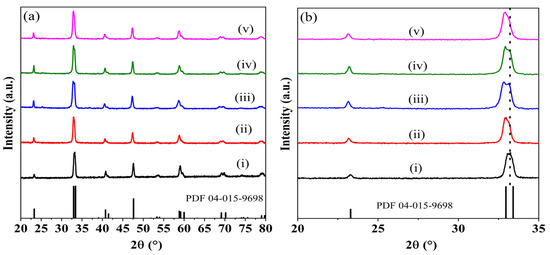
Figure 1.
(a) XRD patterns of freshly synthesized (i) LSCO, (ii) LSPdCO, (iii) LSPtCO, (iv) LSRhCO, and (v) LSRuCO; (b) magnified view.
Rietveld refinement was performed to obtain better insight into the structural modifications caused by the substitution of noble metal ions (see Figure 2). The findings demonstrate that the lattice parameter and the unit cell volume both increase with the addition of noble metals. This is expected as the substitution of noble metal ions for cobalt expands the crystal structure because they are larger in terms of ionic radii [21,54,55]. The refinement’s goodness-of-fit (GOF) values are nearly 1. This suggests that the calculated model (Ycal.) and the observed data (YObs) match quite well, confirming the precision of the fine-tuned structural parameters [54] displayed in Table 2.
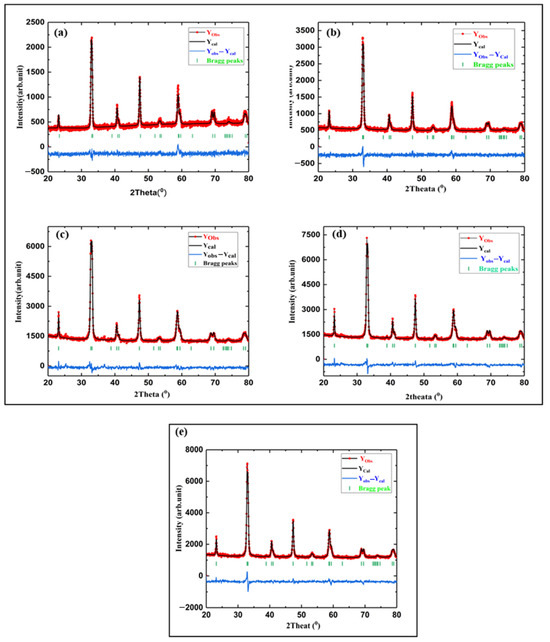
Figure 2.
Rietveld-refined XRD patterns for (a) LSCO, (b) LSPdCO, (c) LSPtCO, (d) LSRhCO, and (e) LSRuCO. Refinement confirms phase purity and supports structural changes due to metal substitution.

Table 2.
Rietveld-refined structural parameters for LSCO and noble metal-substituted LSCO. Table includes lattice constants, unit cell volume, and goodness-of-fit values.
BET of the LSCO and noble metal-substituted LSCO was performed. The BET surface area ranges between 4 and 5 m2/g of catalysts except LSRuCO, which was showing a 12 m2/g surface area. This low surface area of LSCO and LSCO and noble metal-substituted LSCO was attributed to the high temperature of calcination catalysts during the preparation. This high temperature of calcination (800 °C) can cause agglomeration, which is responsible for the low surface area.
It is commonly known that reducibility and surface-active oxygen species of perovskite have a major impact on their catalytic reactivity. We conducted hydrogen temperature-programmed reduction (H2-TPR) experiments to evaluate the reducibility of the catalysts, as represented in Figure 3.
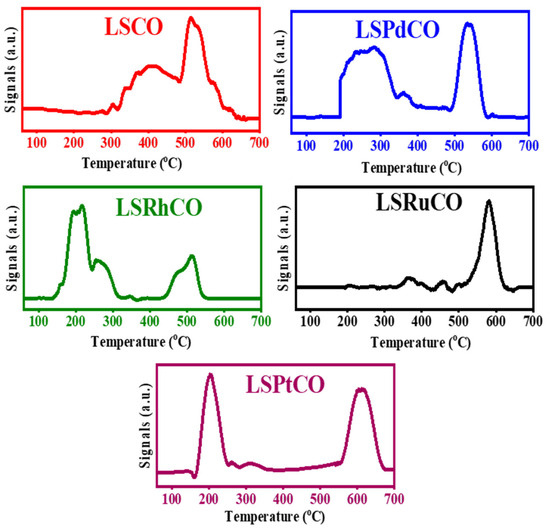
Figure 3.
H2-TPR profiles of LSCO, LSPdCO, LSRhCO, LSRuCO, and LSPtCO. Conditions: H2/N2 (2/18) at 20 mL/min; heating rate of 10 °C/min from room temperature to 700 °C.
LSCO shows two peaks at 300–450 °C for the reduction of Co3+ to Co2+ and a second peak at 500–600 °C for the reduction of Co2+ metallic Co [52,56,57]. The first peak is broad, which suggests a wide range of oxygen species. The second peak is sharp, which provides information regarding the tightly bound oxygen with the lattice of LSCO. These results match with our past work. Cobalt is the only reducible metal in LSCO. Co-O bond breaking is related to more active oxygen during the removal of carbon in the DRM. LSPdCO showed lower reduction temperatures with three peaks at 175–344 °C for the reduction of Co3+ to Co2+, 484–544 °C for the reduction of Co2+ metallic Co, and a shoulder peak appears at 368 °C. Pd lowers the reduction temperature by about 125 °C. This may be due to Pd helping hydrogen split and move across the surface. LSRuCO shows one sharp peak at 585 °C. Two shoulders appear at 368 °C and 456 °C.
It reduces less than other catalysts. LSRhCO reduces at the lowest temperature with the two peaks; the first peak at 130–250 °C, which is related to the reduction of Co3+ to Co2+, and the second peak at 427–547 °C, which is related to the reduction of Co2+ metallic Co. LSRhCO reduces at 115.7 °C, 47.3 °C lower than LSCO, while LSPdCO shows narrow peaks at 251 °C and 617 °C, and a shoulder at 361 °C. Rh and Pd doping increase oxygen release in LSRhCO and LSPdCO. Total H2 consumption was calculated in mmol/g for LSPdCO (10.02), LSRhCO (9.68), LSPtCO (7.20), LSCO (6.4), and LSRuCO (2.52), which is followed by the following terms for total H2 consumption: LSPdCO > LSRhCO > LSPtCO > LSCO > LSRuCO.
3.2. Catalytic Activity for Dry Reforming Reaction
The catalytic activity of LSCO and noble metal-substituted LSCO compounds towards the DRM is shown in Figure 4. Among all the catalysts, LSPdCO exhibited the highest CH4 and CO2 conversions, reaching ~98% and ~100%, respectively, at 800 °C. The sharp rise in CH4 conversion from 550 °C onwards indicates strong CH4 activation. In the case of LSRhCO, CH4 conversion initially reached ~96% at 650 °C, but a noticeable drop in conversion occurred at higher temperatures, suggesting the onset of deactivation likely due to carbon accumulation from CH4 decomposition (CH4 ↔ C + 2H2). For LSCO, the CH4 and CO2 conversions were 66% and 86%, respectively. The higher CO2 conversion than CH4 is attributed to the reverse water–gas shift (RWGS) reaction, also supported by the detection of H2O in the outlet stream. The LSRuCO and LSPtCO catalysts were found to be the least active among all, showing the lowest CH4 and CO2 conversions across the temperature range.
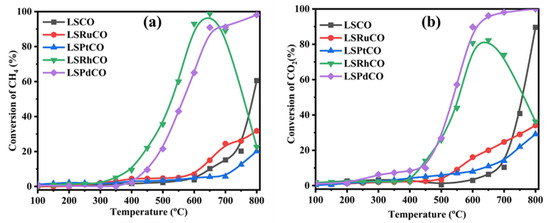
Figure 4.
DRM activity of the LSCO and noble metal (M = Pd, Rh, Ru, Pt) substitution in La1−xSrxCo1−yMyO3: (a) CH4 conversion, (b) CO2 conversion. Reaction condition: CH4:CO2:N2 = 2:2:16 with flow rate = 20 mL/min, T = room temperature to 800 °C P = 1 atm, GHSV = 12,000 h−1.
To evaluate catalyst durability, a 20 h time-on-stream test at 800 °C was performed (Figure 5). The highest deactivation was observed for LSPdCO, which completely lost its activity within 6 h. In contrast, LSCO retained stable activity throughout the 20 h, although its CH4 conversion was lower. The H2/CO ratio for LSCO remained below 1, further confirming the influence of the RWGS reaction.
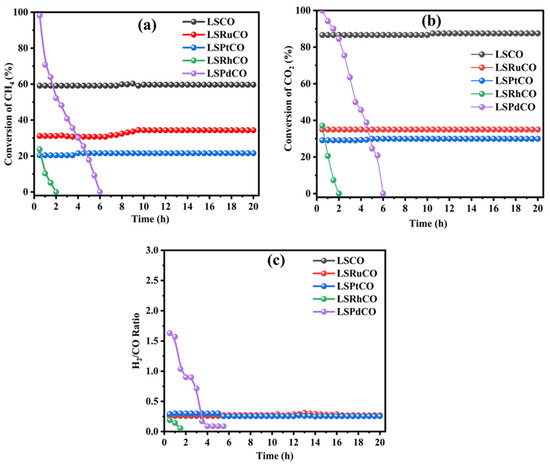
Figure 5.
DRM activity of the LSCO and noble metal (M = Pd, Rh, Ru, Pt) substitution in La1−xSrxCo1−yMyO3: (a) CH4 conversion, (b) CO2 conversion, (c) H2/CO ratio. Reaction condition: CH4:CO2:N2 = 2:2:16 with flow rate = 20 mL/min T = 800 °C P = 1 atm, GHSV = 12,000 h−1.
To further evaluate the deposited carbon after the 20 h DRM, TGA analysis was carried out in Figure 6. Here, the highest and almost the same carbon deposition was shown by LSPdCO and LSCO, at around 19.8%. Here, the only difference is that the TGA profiles were recorded for LSPdCO after a 6 h DRM run while the TGA profiles were recorded for LSCO after the 20 h run. It means that LSPdCO is more prone to carbon deposition, which is why it lost its activity towards the DRM after 6 h. LSRhCO shows around 18.4% carbon deposition; it is one of the reasons for the decrease in activity after 650 °C, as shown in Figure 4.
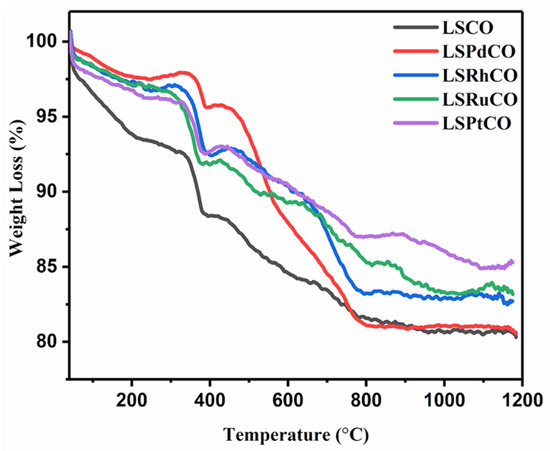
Figure 6.
TGA profiles of spent catalysts after DRM reaction.
The observed catalytic behavior can be correlated with the surface characteristics obtained from the redox behavior from H2-TPR. According to H2-TPR, LSPdCO and LSRhCO exhibit the highest hydrogen uptake and lower reduction onset temperatures in H2-TPR, indicating easier removal of the surface and lattice oxygen at lower temperatures. In LSPdCO, this led to a fast reduction in reactive oxygen species without sufficient renewal, resulting in rapid deactivation. This was confirmed by TGA (Figure 6), where LSPdCO showed almost 19.8% carbon deposition after just 6 h, similar to LSCO after 20 h. LSRhCO showed ~18.4% carbon, correlating with its gradual deactivation. In contrast, LSCO maintained stable activity over the entire period, despite lower conversions, suggesting resistance to rapid deactivation due to the carbon deposition. In comparison, LSRuCO and LSPtCO were least active and most resistant to reduction, as shown by their poor H2 uptake in TPR. Their low oxygen mobility and minimal lattice oxygen contribution explain their inactivity in the DRM. The LSCO catalyst, although less active, showed excellent long-term stability for 20 h. This can be attributed to its moderate reducibility (as shown by H2-TPR). As a result, LSCO avoids rapid deactivation, and its surface remains stable over long operation. In essence, LSCO’s durability arises from a conservative redox profile that enables slow but consistent CO2 activation and carbon removal without depleting the lattice oxygen.
The post-reaction TGA and O2-TPO (after the CH4/CO2 TPSR) results indicate two distinct types of carbon species on the catalyst surface, oxidizable at different temperatures. While full regeneration was not attempted in this study, the oxidative profiles suggest partial regeneration via O2 treatment is feasible.
3.3. CH4/CO2 TPSR and O2-TPO
To further understand the role of lattice oxygen in the removal of carbon during the DRM reaction, we performed CH4-TPSR on LSPdCO. Here, we chose LSPdCO for the CH4/CO2 TPSR because it is the most active catalyst for the DRM among all the noble-substituted LSCO and LSCO, as observed from the conversion curve (Figure 4 and Figure 5).
The CH4-TPSR study shows a higher response of H2, which confirmed the decomposition of CH4 into the C and H2 above 550 °C in Figure 7a. Here, the response of CO was very minor, which started at 650 °C, and again came back to the normal response. This response confirmed the participation of minor lattice oxygen for the removal of carbon, which is very limited. We did not observe any signal regarding the CO2, which further confirms the lesser participation of lattice oxygen. At 695 °C, we observed the decrement in the H2 signal, which indicated that carbon deposition was blocking the site for methane activation. At almost the same temperature (699 °C), we found a signal of CO, which indicates carbon removal by the lattice oxygen. After that, again, we found a rise in the H2 response. It means that the activation site for methane has been regenerated by the lattice oxygen. So, the participation of lattice oxygen is very important for carbon removal. In the CO2 TPSR, we found a very small response to CO at 624 °C, which indicates the role of CO2 as an oxidant in the CO2-TPSR in Figure 4b. In the O2-TPO, we observed the response of the remaining carbon in the form of CO&CO2, as shown in Figure 7c. O2-TPO indicated the two types of carbon deposition on the LSPdCO, which was oxidized by the oxygen at two different temperatures. After the CH4/CO2 TPSR, we still observed the carbon on the LSPdCO. This confirmed why LSPCO is showing the highest amount of carbon in TGA after the 6 h catalytic run at 800 °C.
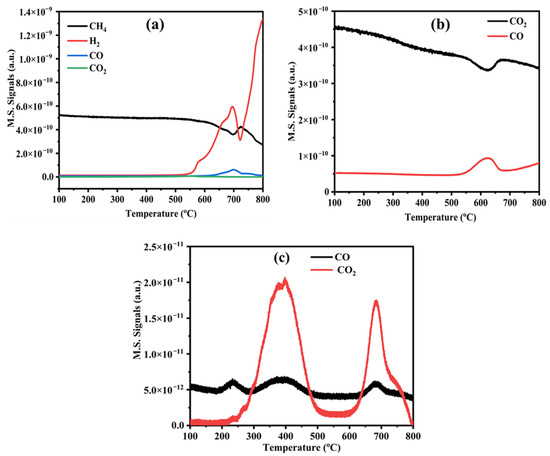
Figure 7.
(a) CH4-TPSR, (b) CO2-TPSR, (c) O2-TPO on the LSPdCO.
From the CH4/CO2 TPSR and O2-TPO, it is evident that the LSPdCO catalyst does not demonstrate active participation of lattice oxygen in the carbon removal process. This lack of reactivity suggests that the lattice oxygen in LSPdCO is not readily available or mobile enough to engage with deposited carbon or with the reactant gases. This mechanistic insight helps explain the observed deactivation of LSPdCO over time. Carbon accumulation on the catalyst surface, a key cause of deactivation in the DRM, cannot be effectively alleviated without the active involvement of lattice oxygen. In contrast, catalysts with redox-active lattice oxygen can oxidize the deposited carbon species, thereby regenerating active sites and enhancing catalyst stability. Our previous studies [58,59,60,61] have demonstrated that the presence and mobility of lattice oxygen play a pivotal role not only in the activation of CH4 but also in maintaining catalyst performance during long-term activity. Catalysts capable of facilitating Mars–van Krevelen-type mechanisms where lattice oxygen participates directly in the redox cycle show improved resistance to coking and enhanced long-term activity.
The present findings confirm that LSPdCO absences this regenerative capacity, highlighting the importance of designing perovskite-based catalysts with highly mobile and reactive lattice oxygen for effective CH4 reforming and carbon mitigation during the reaction.
4. Conclusions
In this study, noble metal-substituted La1−xSrxCo1−yMyO3 (M = Pd, Rh, Ru, Pt) perovskite catalysts were synthesized and tested for the dry reforming of methane (DRM). The results showed that the nature of the B-site dopant influences both the catalytic activity and stability. Among the materials studied, LSPdCO exhibited the highest initial CH4 and CO2 conversions, followed by LSRhCO. This enhanced activity was attributed to improved reducibility and surface oxygen availability, as confirmed by H2-TPR. Despite their high initial performance, both catalysts suffered from rapid deactivation: LSPdCO lost most of its activity within 6 h and LSRhCO showed stability for only 2 h. To investigate the deactivation, CH4/CO2-TPSR and O2-TPO were performed on the LSPdCO catalyst. CH4-TPSR revealed strong methane decomposition but limited CO formation, indicating poor carbon oxidation by lattice oxygen. CO2-TPSR and O2-TPO further confirmed that the catalyst had a very limited ability to regenerate active oxygen species, leading to significant carbon generation. These findings demonstrate that although noble metal doping enhances initial CH4 and CO2 activation in LSPdCO and LSRhCO, the DRM performance requires not only good reducibility but also the ability to maintain and regenerate lattice oxygen under reaction conditions. Without this, even highly active catalysts like LSPdCO and LSRhCO are quickly deactivated by carbon accumulation. These studies confirmed that lattice oxygen is essential for maintaining catalytic activity under reaction conditions. In the case of LSPdCO, its limited lattice oxygen participation led to rapid carbon accumulation and the most severe deactivation among the tested catalysts.
Author Contributions
P.K.Y.: Conceptualization, methodology, experimental investigation, formal analysis, data curation, visualization, writing—original draft preparation, G.J.: data curation, visualization, writing—original draft preparation, S.S.: supervision, project administration, writing review and editing. All authors have read and agreed to the published version of the manuscript.
Funding
The article processing charges (APCs) were covered using reviewer vouchers provided by P.K.Y. P.K.Y. gratefully acknowledges the support of IIT Gandhinagar for the PhD fellowship.
Data Availability Statement
The original contributions presented in this study are included in the article. Further inquiries can be directed to the corresponding author.
Acknowledgments
The authors gratefully acknowledge the Central Instrumentation Facility (CIF) at IIT Gandhinagar for their support and assistance in carrying out this work.
Conflicts of Interest
The author declares no conflicts of interest.
Abbreviations
| Abbreviation | Full Form |
| DRM | Dry reforming of methane |
| TPSR | Temperature-programmed surface reaction |
| TPO | Temperature-programmed oxidation |
| TGA | Thermogravimetric analysis |
| H2-TPR | Hydrogen temperature-programmed reduction |
| XRD | X-ray diffraction |
| BET | Braeuer–Emmett–Teller (Surface Area Measurement) |
| GC | Gas chromatography |
| FTS | Fischer–Tropsch synthesis |
| RWGS | Reverse water–gas shift |
| ODH | Oxalyldihydrazide |
| GHSV | Gas hourly space velocity |
| RT | Room temperature |
References
- Royer, S.; Duprez, D. Catalytic Oxidation of Carbon Monoxide over Transition Metal Oxides. ChemCatChem 2011, 3, 24–65. [Google Scholar] [CrossRef]
- Yentekakis, I.V.; Goula, G.; Hatzisymeon, M.; Betsi-Argyropoulou, I.; Botzolaki, G.; Kousi, K.; Kondarides, D.I.; Taylor, M.J.; Parlett, C.M.A.; Osatiashtiani, A.; et al. Effect of support oxygen storage capacity on the catalytic performance of Rh nanoparticles for CO2 reforming of methane. Appl. Catal. B Environ. 2019, 243, 490–501. [Google Scholar] [CrossRef]
- Hegde, M.S.; Madras, G.; Patil, K.C. Noble Metal Ionic Catalysts. Acc. Chem. Res. 2009, 42, 704–712. [Google Scholar] [CrossRef] [PubMed]
- Rajesh, T.; Upadhyay, A.; Sinha, A.K.; Deb, S.K.; Devi, R.N. Effect of Pt incorporation in LaBO3 (B=Mn, Fe, Co) perovskites on water gas shift activity. J. Mol. Catal. A Chem. 2014, 395, 506–513. [Google Scholar] [CrossRef]
- Villoria, J.-A.; Mota, N.; Al-Sayari, S.A.; Alvarez-Galvan, M.-C. Perovskites as Catalysts in the Reforming of Hydrocarbons: A Review. Micro Nanosyst. 2012, 4, 231–252. [Google Scholar] [CrossRef]
- Ziaei-Azad, H.; Khodadadi, A.; Esmaeilnejad-Ahranjani, P.; Mortazavi, Y. Effects of Pd on Enhancement of Oxidation Activity of LaBO3 (B = Mn, Fe, Co and Ni) Pervoskite Catalysts for Pollution Abatement from Natural Gas Fueled Vehicles. Appl. Catal. B: Environ. 2011, 102, 62. [Google Scholar] [CrossRef]
- Juhász, K.; Lévay, K.; Hegedűs, L.; Balogh-Weiser, D.; Pirault-Roy, L.; Hell, Z. Application of supported lanthanum catalysts in the hydrogenation of nitriles. React. Kinet. Mech. Catal. 2021, 133, 687–698. [Google Scholar] [CrossRef]
- Kantam, M.L.; Kishore, R.; Yadav, J.; Sudhakar, M.; Venugopal, A. Chemoselective Hydrogenation of the Olefinic Bonds Using a Palladium/Magnesium-Lanthanum Mixed Oxide Catalyst. Adv. Synth. Catal. 2012, 354, 663–669. [Google Scholar] [CrossRef]
- Royer, S.; Duprez, D.; Kaliaguine, S. Oxygen mobility in LaCoO3 perovskites. Catal. Today 2006, 112, 99–102. [Google Scholar] [CrossRef]
- Royer, S.; Van Neste, A.; Davidson, R.; McIntyre, S.; Kaliaguine, S. Methane Oxidation over Nanocrystalline LaCo1-XFeXO3: Resistance to SO2 Poisoning. ACS Catal. 2004, 43, 5670–5680. [Google Scholar] [CrossRef]
- Sarshar, Z.; Kleitz, F.; Kaliaguine, S. Novel oxygen carriers for chemical looping combustion: La1−xCexBO3 (B = Co, Mn) perovskites synthesized by reactive grinding and nanocasting. Energy Environ. Sci. 2011, 4, 4258–4269. [Google Scholar] [CrossRef]
- Keav, S.; Matam, S.K.; Ferri, D.; Weidenkaff, A. Structured Perovskite-Based Catalysts and Their Application as Three-Way Catalytic Converters—A Review. Catalysts 2014, 4, 226–255. [Google Scholar] [CrossRef]
- Lim, H.S.; Lee, M.; Kim, Y.; Kang, D.; Lee, J.W. Low-temperature CO2 hydrogenation to CO on Ni-incorporated LaCoO3 perovskite catalysts. Int. J. Hydrogen Energy 2021, 46, 15497–15506. [Google Scholar] [CrossRef]
- Sakpal, T.; Lefferts, L. Structure-dependent activity of CeO2 supported Ru catalysts for CO2 methanation. J. Catal. 2018, 367, 171–180. [Google Scholar] [CrossRef]
- García-Moncada, N.; Navarro, J.C.; Odriozola, J.A.; Lefferts, L.; Faria, J.A. Enhanced catalytic activity and stability of nanoshaped Ni/CeO2 for CO2 methanation in micro-monoliths. Catal. Today 2021, 383, 205–215. [Google Scholar] [CrossRef]
- Aneggi, E.; Llorca, J.; Boaro, M.; Trovarelli, A. Surface-structure sensitivity of CO oxidation over polycrystalline ceria powders. J. Catal. 2005, 234, 88–95. [Google Scholar] [CrossRef]
- Jin, T.; Okuhara, T.; Mains, G.J.; White, J.M. Temperature-programmed desorption of carbon monoxide and carbon dioxide from platinum/ceria: An important role for lattice oxygen in carbon monoxide oxidation. J. Phys. Chem. 1987, 91, 3310–3315. [Google Scholar] [CrossRef]
- Granger, P.; Parvulescu, V.I. Catalytic NOx Abatement Systems for Mobile Sources: From Three-Way to Lean Burn after-Treatment Technologies. Chem. Rev. 2011, 111, 3155–3207. [Google Scholar] [CrossRef]
- Lambrou, P.S.; Efstathiou, A.M. The effects of Fe on the oxygen storage and release properties of model Pd–Rh/CeO2–Al2O3 three-way catalyst. J. Catal. 2006, 240, 182–193. [Google Scholar] [CrossRef]
- Tejuca, L.G.; Fierro, J.L.G.; Tascón, J.M.D. Advance in Catalysis. In Structure and Reactivity of Perovskite-Type Oxides; Elsevier: Amsterdam, The Netherlands, 1989; Volume 36, pp. 237–328. [Google Scholar]
- Bisht, A.; Zhang, P.; Shivakumara, C.; Sharma, S. Pt-Doped and Pt-Supported La1–xSrxCoO3: Comparative Activity of Pt4+and Pt0Toward the CO Poisoning Effect in Formic Acid and Methanol Electro-oxidation. J. Phys. Chem. C 2015, 119, 14126–14134. [Google Scholar] [CrossRef]
- Forni, L.; Oliva, C.; Vatti, F.P.; Kandala, M.A.; Ezerets, A.M.; Vishiakov, A.V. La-Ce-Co perovskites as catalysts for exhaust gas depollution. Appl. Catal. A Gen. 1996, 7, 269–284. [Google Scholar] [CrossRef]
- Arandiyan, H.; Dai, H.; Deng, J.; Liu, Y.; Bai, B.; Wang, Y.; Li, X.; Xie, S.; Li, J. Three-dimensionally ordered macroporous La0.6Sr0.4MnO3 with high surface areas: Active catalysts for the combustion of methane. J. Catal. 2013, 307, 327–339. [Google Scholar] [CrossRef]
- Deng, J.; Zhang, L.; Dai, H.; He, H.; Au, C.T. Hydrothermally fabricated single-crystalline strontium-substituted lanthanum manganite microcubes for the catalytic combustion of toluene. J. Mol. Catal. A Chem. 2009, 299, 60–67. [Google Scholar] [CrossRef]
- Huang, K.; Chu, X.; Yuan, L.; Feng, W.; Wu, X.; Wang, X.; Feng, S. Engineering the surface of perovskite La0.5Sr0.5MnO3 for catalytic activity of CO oxidation. Chem. Commun. 2014, 50, 9200–9203. [Google Scholar] [CrossRef]
- Arai, H.; Yamada, T.; Eguchi, K.; Seiyama, T. Catalytic combustion of methane over various perovskite-type oxides. Appl. Catal. 1986, 26, 265–276. [Google Scholar] [CrossRef]
- Bian, Z.; Das, S.; Wai, M.H.; Hongmanorom, P.; Kawi, S. A Review on Bimetallic Nickel-Based Catalysts for CO2 Reforming of Methane. ChemPhysChem 2017, 18, 3117. [Google Scholar] [CrossRef]
- Das, S.; Ashok, J.; Bian, Z.; Dewangan, N.; Wai, M.H.; Du, Y.; Borgna, A.; Hidajat, K.; Kawi, S. Silica–Ceria Sandwiched Ni Core–shell Catalyst for Low Temperature Dry Reforming of Biogas: Coke Resistance and Mechanistic Insights. Appl. Catal. B Environ. 2018, 230, 220. [Google Scholar] [CrossRef]
- Wang, K.; Zhong, P. A kinetic study of Co oxidation over the perovskite-like oxide LaSrNio4. J. Serb. Chem. Soc. 2010, 75, 249–258. [Google Scholar] [CrossRef]
- Das, S.; Bhattar, S.; Liu, L.; Wang, Z.; Xi, S.; Spivey, J.J.; Kawi, S. Effect of Partial Fe Substitution in La0.9Sr0.1NiO3 Perovskite-Derived Catalysts on the Reaction Mechanism of Methane Dry Reforming. ACS Catal. 2020, 10, 12466–12486. [Google Scholar] [CrossRef]
- Jangam, A.; Das, S.; Dewangan, N.; Hongmanorom, P.; Hui, W.M.; Kawi, S. Conversion of CO2 to C1 Chemicals: Catalyst Design, Kinetics and Mechanism Aspects of the Reactions. Catal. Today 2020, 358, 3–29. [Google Scholar] [CrossRef]
- Oemar, U.; Ang, M.L.; Hee, W.F.; Hidajat, K.; Kawi, S. Perovskite LaxM1-xNi0.8Fe0.2O3 Catalyst for Steam Reforming of Toluene: Crucial Role of Alkaline Earth Metal at Low Steam Condition. Appl. Catal. B Environ. 2014, 148–149, 231. [Google Scholar] [CrossRef]
- Kawi, S.; Kathiraser, Y.; Ni, J.; Oemar, U.; Li, Z.; Saw, E.T. Progress in Synthesis of Highly Active and Stable Nickel-Based Catalysts for Carbon Dioxide Reforming of Methane. ChemSusChem 2015, 8, 3556. [Google Scholar] [CrossRef] [PubMed]
- Pakhare, D.; Spivey, J. A review of Dry (CO2) Reforming of Methane over Noble Metal Catalysts. Chem. Soc. Rev. 2014, 43, 7813. [Google Scholar] [CrossRef] [PubMed]
- Pakhare, D.; Schwartz, V.; Abdelsayed, V.; Haynes, D.; Shekhawat, D.; Poston, J.; Spivey, J. Kinetic and Mechanistic Study of Dry (CO2) Reforming of Methane over Rh-substituted La2Zr2O7 Pyrochlores. J. Catal. 2014, 316, 78. [Google Scholar] [CrossRef]
- Bonmassar, N.; Bekheet, M.F.; Schlicker, L.; Gili, A.; Gurlo, A.; Doran, A.; Gao, Y.; Heggen, M.; Bernardi, J.; Klötzer, B.; et al. In Situ-Determined Catalytically Active State of LaNiO3 in Methane Dry Reforming. ACS Catal. 2020, 10, 1102. [Google Scholar] [CrossRef]
- Sutthiumporn, K.; Kawi, S. Promotional Effect of Alkaline Earth over Ni–La2O3 Catalyst for CO2 Reforming of CH4: Role of Surface Oxygen Species on H2 Production and Carbon Suppression. Int. J. Hydrogen Energy 2011, 36, 14435. [Google Scholar] [CrossRef]
- Sutthiumporn, K.; Maneerung, T.; Kathiraser, Y.; Kawi, S. CO2 Dry-reforming of Methane over La0.8Sr0.2Ni0.8M0.2O3 Perovskite (M = Bi, Co, Cr, Cu, Fe): Roles of Lattice Oxygen on C–H Activation and Carbon Suppression. Int. J. Hydrogen Energy 2012, 37, 11195. [Google Scholar] [CrossRef]
- Chen, S.; Yang, T.; Lu, H.; Liu, Y.; He, Y.; Li, Q.; Gao, J.; Feng, J.; Yan, H.; Miller, J.T.; et al. Increased Hydrogenation Rates in Pd/La-Al2O3 Catalysts by Hydrogen Transfer O(-La) Sites Adjacent to Pd Nanoparticles. ACS Catal. 2022, 12, 15696–15706. [Google Scholar] [CrossRef]
- Zheng, X.; Lin, H.; Zheng, J.; Duan, X.; Yuan, Y. Lanthanum Oxide-Modified Cu/SiO2 as a High-Performance Catalyst for Chemoselective Hydrogenation of Dimethyl Oxalate to Ethylene Glycol. ACS Catal. 2013, 3, 2738–2749. [Google Scholar] [CrossRef]
- Liu, Y.-C.; Chen, Y.-W. Hydrogenation of p-Chloronitrobenzene on Lanthanum-Promoted NiB Nanometal Catalysts. Ind. Eng. Chem. Res. 2006, 45, 2973–2980. [Google Scholar] [CrossRef]
- Tsipouriari, V.A.; Verykios, X.E. Kinetic Study of the Catalytic Reforming of Methane with Carbon Dioxide to Synthesis Gas over Ni/La2O3 Catalyst. Catal. Today 2001, 64, 83. [Google Scholar] [CrossRef]
- Tsipouriari, V.A.; Verykios, X.E. Carbon and Oxygen Reaction Pathways of CO2 Reforming of Methane over Ni/La2O3 and Ni/Al2O3 Catalysts Studied by Isotopic Tracing Techniques. J. Catal. 1999, 187, 85. [Google Scholar] [CrossRef]
- Li, X.; Zhao, Z.J.; Zeng, L.; Zhao, J.; Tian, H.; Chen, S.; Li, K.; Sang, S.; Gong, J. On the Role of Ce in CO2 Adsorption and Activation over Lanthanum Species. Chem. Sci. 2018, 9, 3426. [Google Scholar] [CrossRef]
- Li, Z.; Das, S.; Hongmanorom, P.; Dewangan, N.; Wai, M.H.; Kawi, S. Silica-based Micro- and Mesoporous Catalysts for Dry Reforming of Methane. Catal. Sci. Technol. 2018, 8, 2763. [Google Scholar] [CrossRef]
- Wen, W.; Wang, X.; Jin, S.; Wang, R. LaCoO3 perovskite in Pt/LaCoO3/K/Al2O3 for the improvement of NOx storage and reduction performances. RSC Adv. 2016, 6, 74046–74052. [Google Scholar] [CrossRef]
- Marcos, J.A.; Buitrago, R.H.; Lombardo, E.A. Surface chemistry and catalytic activity of La1 − yMyCoO3 perovskite (M = Sr or Th): 1. Bulk and surface reduction studies. J. Catal. 1987, 105, 95–106. [Google Scholar] [CrossRef]
- Nakamura, T.; Petzow, G.; Gauckler, L.J. Stability of the Perovskite Phase LaBO3 (B = V, Cr, Mn, Fe, Co, Ni) in Reducing Atmosphere I. Experimental Results. Mater. Res. Bull. 1979, 14, 649. [Google Scholar] [CrossRef]
- Peng, Y.; Si, W.; Luo, J.; Su, W.; Chang, H.; Li, J.; Hao, J.; Crittenden, J. Surface Tuning of La0.5Sr0.5CoO3 Perovskite Catalysts by Acetic Acid for NOx Storage and Reduction. Environ. Sci. Technol. 2016, 50, 6442–6448. [Google Scholar] [CrossRef] [PubMed]
- Patil, K.C.; Hegde, M.S.; Rattan, T.; Aruna, S.T. Chemistry of Nanocrystalline Oxide Materials; World Scientific: Singapore, 2008. [Google Scholar]
- Bisht, A.; Yadav, P.K.; Dhakar, S.; Sharma, S. Pt4+ as an Active Site for Oxygen Evolution Reaction in La1–xSrxCo1–yPtyO3. J. Phys. Chem. C 2021, 125, 25488–25496. [Google Scholar] [CrossRef]
- Bisht, A.; Sihag, A.; Satyaprasad, A.; Mallajosyala, S.S.; Sharma, S. Pt Metal Supported and Pt4+ Doped La1−xSrxCoO3: Non-performance of Pt4+ and Reactivity Differences with Pt Metal. Catal. Lett. 2018, 148, 1965–1977. [Google Scholar] [CrossRef]
- Yadav, P.K.; Kumari, S.; Naveena, U.; Deshpande, P.A.; Sharma, S. Insights into the substitutional chemistry of La1−xSrxCo1−yMyO3 (M = Pd, Ru, Rh, and Pt) probed by in situ DRIFTS and DFT analysis of CO oxidation. Appl. Catal. A Gen. 2022, 643, 118768. [Google Scholar] [CrossRef]
- Sukumar, M.; Kennedy, L.J.; Vijaya, J.J.; Al-Najar, B.; Bououdina, M. Structural, magnetic and catalytic properties of La2-xBaxCuO4 (0 ≤ x ≤ 0.5) perovskite nanoparticles. Ceram. Int. 2018, 44, 18113–18122. [Google Scholar] [CrossRef]
- Bisht, A.; Pentyala, P.; Deshpande, P.A.; Sharma, S. La0.80Sr0.20CoO3 as a noble-metal-free catalyst for the direct oxidation of formic acid under zero applied potential. Electrochem. Commun. 2019, 99, 1–4. [Google Scholar] [CrossRef]
- Chica, A.; Sayas, S. Effective and stable bioethanol steam reforming catalyst based on Ni and Co supported on all-silica delaminated ITQ-2 zeolite. Catal. Today 2009, 146, 37–43. [Google Scholar] [CrossRef]
- Futai, M.; Yonghua, C.; Louhui. Characterization of perovskite-type oxide catalysts RECoO3 by TPR. React. Kinet. Catal. Lett. 1986, 31, 47–54. [Google Scholar] [CrossRef]
- Kumar Yadav, P.; Sharma, S. Ni, Co & Cu substituted CeO2: A catalyst that improves H2/CO ratio in the dry reforming of methane. Fuel 2024, 358, 130163. [Google Scholar]
- Yadav, P.K.; Patrikar, K.; Mondal, A.; Sharma, S. Ni/Co in and on CeO2: A comparative study on the dry reforming reaction. Sustain. Energy Fuels 2023, 7, 3853–3870. [Google Scholar] [CrossRef]
- Yadav, P.K.; Verma, P.; Sharma, S. Bimetal (CuNi and CuCo) substituted CeO2: An approach for low temperature dry reforming of methane. Mol. Catal. 2024, 565, 114398. [Google Scholar] [CrossRef]
- Gangwar, B.P.; Mitra, R.; Parui, A.; Gakhad, P.; Yadav, P.K.; Singh, A.K.; Tiwary, C.S.; Biswas, K.; Sharma, S. Utilization of High Entropy Alloy (Co–Cu–Fe–Mn–Ni) and Support (CeO2) Interaction for CO2 Conversion into Syngas. Adv. Sustain. Syst. 2024, 8, 2400219. [Google Scholar] [CrossRef]
Disclaimer/Publisher’s Note: The statements, opinions and data contained in all publications are solely those of the individual author(s) and contributor(s) and not of MDPI and/or the editor(s). MDPI and/or the editor(s) disclaim responsibility for any injury to people or property resulting from any ideas, methods, instructions or products referred to in the content. |
© 2025 by the authors. Licensee MDPI, Basel, Switzerland. This article is an open access article distributed under the terms and conditions of the Creative Commons Attribution (CC BY) license (https://creativecommons.org/licenses/by/4.0/).